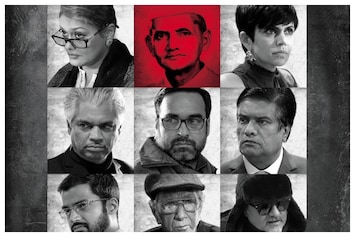Lal Bahadur Shastri’s mysterious death was met my several
theories, some historians vouch for natural death or heart attack, other scholars
and politicians are of the opinion that Shastri Ji was either poisoned or
murdered.
No substantial evidence supporting either of the claims
has come to the forefront, but one thing is for sure, Shastri Ji died twice,
once in Tashkent and another time, he was killed from the memory of the Indians.
Background of Lal Bahadur Shastri:
The Tashkent Files, centered on the life of the “Politician
who had no money”, also known as Lal Bahadur Shastri, gives us a synopsis of
his life.
The petite man of great stature, who made Prime Minister after
the death of Jawaharlal Nehru, was the one behind the Green and the White Revolution,
the same man gave India a voice against casteism and gave India the very slogan
of “Jai Jawaan, Jai Kissan”.
After India’s landslide victory in the Indo-Pak War, Shastri
Ji went to Tashkent, Uzbekistan to sign the peace treaty. Within a few hours of
signing the Treaty, he left for his heavenly abode, reasons for which still
remain unknown.
Theories and Narratives of the mysterious death:
The following theories have been highlighted by way of
the film-
From the historian’s point of view, Lal Bahadur Shastri
was a heart patient, and having suffered 2 heart attacks, made his heart weaker
and thus unable to survive the third one.
From the point of view of the racists, Shastri Ji’s milk
was poisoned by his cook, Jaan Mohammed.
From the International political perspective, Shastri Ji
was murdered by the Russians who wanted to turn India into an ally and Shastri
Ji was an obstacle in their path.
From the Indian political view, the Nehru-Gandhi Clan plotted to assassinate him, in order to gain control over India by handing over the reins to Indira. The motive was allegedly carried about by the CIA and other international agencies.
An Overview of the Movie:
A 2019 film, The Tashkent Files, stands testimony to the
fact that India in 1966 had no interest to investigate the cause of the death
of Shastri Ji and neither does it today. Politics and political leaders have
only used it to frame an agenda in their election rally’s.
The film revolves around a young political journalist who
investigates the cause of the mysterious death of Lal Bahadur Shastri by
pinning down the government and undermining its authority.
The Committee investigating the cause:
In the film, A probe to find the truth results in the formation
of a committee of 8. Its members represent those from different schools of
thought and walks of life.
The committee not only gives us a deep insight into the
background of the mysterious death, but also provides us with several rumours
and conspiracy theories that made the rounds in 1966.
Conjecture based on two different medical and death
reports also comes to light along with several archive documents that dig
further into the filth of politics and its association with unsolved mystery.
The committee highlights the modern-day problems of
corruption, racism, bureaucracy, socialism and the division of opinion based on
the same. The narrow mindset of those politicians, who divide the country on the
basis of religion and race is well represented.
Take-away from the film:
The masterpiece created by, Vivek Agnihotri aims at
encouraging the youth to ask questions about matters affecting the nation and
use their right to information as a tool to challenge the tyranny created by the
politicians.
As the movie progressed, I underwent a lot of strong
emotions ranging from sadness and despair to anger. Anger because of the act of
suppressing and withholding information from the public who could have played a
crucial role in bringing justice to a noble leader like Shastri Ji. Despair because
even after everything is out in the public domain, we have time and again been
enslaved and cheated by our very own politicians, judges, social workers,
media, historians and activists, who claim to have won us our independence.
The Tashkent files, with its exceptional casting, direction,
background score, argumentative scenes, and the portrayal of real-life politics
makes it a work of art, which no Indian should miss out on.
Written by - Tushna Choksey










.jpeg)


.JPG)
0 Comments